
This page is part of © FOTW Flags Of The World website
Central African Republic
République Centrafricain
Last modified: 2018-12-26 by bruce berry
Keywords: central african republic | star | french equatorial africa | pan-african |
Links: FOTW homepage |
search |
disclaimer and copyright |
write us |
mirrors
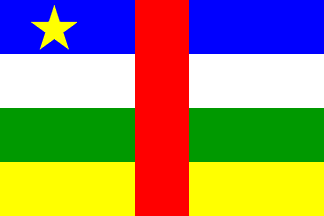
![[National flag]](../misc/oooxxx.gif) 2:3
Image by Željko Heimer, 11 May 2001
2:3
Image by Željko Heimer, 11 May 2001
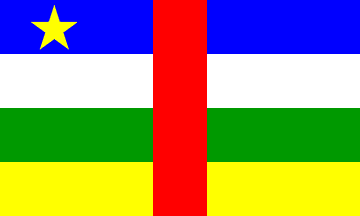
![[National flag]](../misc/oooxxx.gif) 3:5
Image by Željko Heimer and António Martins-Tuválkin, 25 May 2008
3:5
Image by Željko Heimer and António Martins-Tuválkin, 25 May 2008
Flag adopted on 01 December 1958
and the Coat of Arms adopted on 17 May 1963.
See also:
Background
The Central African Republic (CAR) is a landlocked country in
central
Africa. It borders Chad in the north,
Sudan in the north east,
South Sudan in the east, the
Democratic
Republic of Congo and the
Republic of the Congo
in the south, and Cameroon in
the west. Since most of the territory is located in the Ubangi and
Shari river basins, the territory was called Ubangi-Chari when colonised
by France in the 19th century (or Oubangui-Chari in French). It
was part of French Equatorial Africa (Afrique-Equatoriale-française)
which existed between 1910 to 1958 as the federation of the four
colonies of Gabon, Moyen-Congo (now the Republic
of Congo), Oubangui-Chari (now the Central African Republic), and Chad.
It became a semi-autonomous territory within the French Community on 01
December 1958 and obtained independence on 13 August 1960 (Source:
Wikipedia).
There was no distinctive colonial flag and the
French tricolore was used prior to independence.
Bruce Berry, 12 May 2009
Symbolism and specifications of the National Flag
The national flag of the Central African Republic has four horizontal stripes of blue, white, green and yellow flag with fifth
vertical red stripe in the centre. There is a
yellow five-pointed star in the canton. In Album des pavillons nationaux et
des marques distinctives (National flags and distinctive markings) 2000
edition
[pay00]
the ratio of the flag is given as 2:3 with a note claiming that there exists a variant in
the ratio of 3:5. By comparison, Whitney Smith's Flags Through the Ages
and Across the World (1975) [smi75b] and
Flags and Arms across the World (1980) [smi80] gives
the ratio as 3:5~, the Shipmate
Chart gives it as 3:5, while Alfred Znamierowski in The World Encyclopedia of
Flags: The Definitive Guide to International Flags, Banners, Standards and
Ensigns (1999) [zna99] says "Proportions unspecified", which is probably closest to the
truth.
According to Smith (1982) [smi82] the colours were chosen to represent
France (the colonial power) and
the Pan African colours. What is common - red as blood - is superimposed to symbolize that Europeans and Africans have to respect each other. Yellow star of independence symbolizes a bright future.
The flag was officially hoisted on 01 December 1958.
Željko Heimer 11 May 2001
Album 2000 [pay00] gives the construction details as (2+2+2+2):(5+2+5),
but I am somehow doubtful about this as I believe that the numbers 5 are here
are obtained from the firm overall ratio (2:3, which is not quite
certain as discussed above) and the requirement that the vertical stripe
be of equal width as each of the horizontal stripes (the requirement
seems to be implicit, but followed quite strictly). L'Album (1995) also give two possibilities for the ratio, but it
also specifies the position of the star, namely that its center is point 0.14b from hoist where b is the flag
length.
While doing these images, I made image with ratio 4:5. While I
have no sources or proof that such flag exists, but I think that
this might have been the original idea - although probably never actually used -
for the sake of the "conformity" with other "normal" flags (such as 2:3 or 3:5).
The idea here is that all the five stripes are of equal size (area) in the flag.
Željko Heimer 11 May 2001
The colours of the Central African Republic were adopted unanimously by
acclamation during the session of the Legislative Assembly on 01 December 1958
[1].
Before the vote, President Barthélémy Boganda said to the Deputies:
"Those colours, which symbolize
the four territories constituting the French Equatorial Africa [2] but also our guide territory, the
Metropolitan France [3], came out of my heart. The red stripe which crosses the four colours is
the symbol of our blood. As we did it when France was in danger [4], we shall shed our blood for Africa
and to protect the Central African Republic, member of the French Community [5]."
The blue [colour], placed as the sky, stands for Vastness, Freedom, Greatness, Serenity.
The white [colour] recalls Naivety, Purity, Frankness, Bravery, Confidence, Dignity, Equality.
The green [colour] is the symbol of Hope, Belief and Faith.
The yellow [colour] marks Tolerance, Hospitality, Charity.
Therefore, the Central African flag expresses Barthélémy Boganda's aspiration to the unity of
all men in the world, but mostly to the African Unity, powerful in its rich and harmonious diversity
(Source: "République Centrafricaine - Na-Ndouzou" published c. 1969 on behalf of
the Presidency of the Central African Republic by the Editions Delroisse , Boulogne-Billancourt, France). The text was edited by a commission presided by N. Kombot-Naguemon.
Notes (mine):
[1] In 1950, Barthélémy Boganda, the first Deputy (in the French National Assembly) from Oubangui-Chari,
funded the MESAN (Mouvement pour l'évolution sociale de l'Afrique noire, Movement for the Social Evolution
of Black Africa). The Central African Republic was proclaimed in 1958, with Boganda as President, and
became fully independent in 1959, David Dacko succeding to Boganda, deceased the same year. In 1965, Dacko was
overthrown by Jean-Bedel Bokassa, later appointed President for life in 1972 and crowned Emperor in 1976,
with the shameful and ridiculous support of France. In 1979, France turned the tables and helped Dacko to
overthrow Bokassa (or rather overthrew Bokassa and placed Dacko on the vacant throne). Dacko was himself
overthrown by Kolingba two years later. Since then, the Central African Republic has
significant unrest
"arbitrated" by France, which keeps troops stationed in Bangui, the capital.
[2] French Equatorial Africa (AEF, Afrique-Equatoriale-française) existed from 1910 to 1958,
as the federation of the four colonies of Gabon, Moyen-Congo (now the Republic of Congo), Oubangui-Chari
(now the Central African Republic) and Chad.
[3] France Metropolitan (code FX in ISO3166) is European France.
[4] This is a clear reference to Félix Eboué (1884-1944). Eboué was born in Cayenne
(French Guyana) and was the first Black Colonial Governor, first in Guadeloupe (1936)
and
then in Chad (1938). Following de Gaulle's call on 18 June 1940, Eboué rallied the Free France,
and the AEF served as territorial basis for the Free France.
[5] The French Community (Communauté française) was founded in 1958. It grouped France, the Overseas
Departments and Territories, and several of the former French colonies in Africa. It progressively
decreased and ceased to function in 1960, although the Community was constitutionally abolished only in 1995!
The flag of the Communauté was a square tricolor flag with a golden fringe and LIBERTE EGALITE FRATERNITE written
in gold in the middle of the flag (one word per line).
Ivan Sache, 24 Dec 2002
The protocol manual for the London 2012 Olympics
(Flags and Anthems Manual, London, 2012 ) [loc12]
provides recommendations for national flag designs. Each National Olympic
Committee was sent an image of their flag, including the PMS shades, by the
London Organising Committee of the Olympic Games (LOCOG) for their approval.
Once this was obtained, the LOCOG produced a 60 x 90 cm version of the flag for
further approval. So, while these specifications may not be the official,
government, version of each flag, they are certainly what the National Olympic
Committee believed their flag to be.
For the CAR : PMS 293 blue, 032 red, 355 green, 109 yellow. The vertical flag is
the horizontal version reversed and turned 90 degrees anti-clockwise - blue to
the left, and the star pointing left in the top left corner.
Ian Sumner,
10 Oct 2012
Flag in the Constitution
A new Constitution was promulgated in Central African Republic on 14 January 1995,
after having been accepted on 28 December 1994 by 82.06% of the voters. Article 17 of the
Constitution describes the flag as follows:
Title II
The State and Sovereignty
Article 17
[...]
Its emblem is the flag of four equal sized horizontal bands of the colours blue, white, green and yellow, perpendicularly barred in their centre by a red band of equal size and marked in the upper left corner by a yellow five pointed star.
Its motto is UNITY - DIGNITY - WORK
[...]
The Seals of the State and the Arms of the Republic are defined by the law.
Source: Pascal Vagnat & Jos Poels, Constitutions - What they tell us about national flags and coat of arms,
published by SAVA (2000) [vap00].
Ivan Sache, 24 December 2002
Coat of Arms
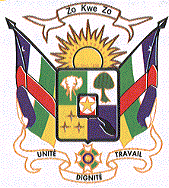 From http://www.chez.com/mdicentrafrique/sango.htm, located by Dov Gutterman, 10 Mar 1999
From http://www.chez.com/mdicentrafrique/sango.htm, located by Dov Gutterman, 10 Mar 1999
Presidential flag
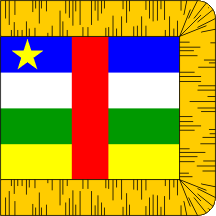 image by Željko Heimer, 11 May 2001
image by Željko Heimer, 11 May 2001
Whitney Smith in Flags Through the Ages and Across the World (1975) [smi75b]
shows a Presidential flag for the CAR.
However, more recent sources do not mention this
presidential standard as being reintroduced after the Bokassa period when the
country was known as the Central African Empire.
The
presidential flag follows the same design as the national flag with wide
golden fringe on three sides with the ratio given as 22:31~ (which excludes the
fringe).
I made this illustration with the flag ratio 4:5, which together with fringe on three sides make the flag
exactly square.
Željko Heimer, 11 May 2001
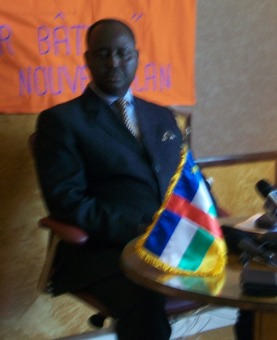 Image sent by Aleksandar Nemet, 28 Jan 2010
Image sent by Aleksandar Nemet, 28 Jan 2010
This photograph shows a fringed flag of the CAR, possibly the President's
standard. It does not appear to be square as indicated by Željko Heimer
above.
Aleksandar Nemet, 28 Jan 2010
Use of the flag by political parties
It seems that the political parties are forbidden to use the national flag
for party political purposes. For example, the party MDI was forced to remove the national flag from their
website and the disclaimer
(in French) says:
'The flag of the Central African Republic, heritage of all of the
Central Africans, has been removed from this website because we have been
ordered to do so by the State Prosecutor of the Central African Republic,
on pain of penalties. Therefore we removed it to avoid any financial loss to our party. The
surfers and the Central Africans are free to appreciate this democratic
advance in President's Boganda's country".
Ivan Sache, 07 Feb 2001
Erroneous depiction of the flag on stamps
Two variants of the Central African flag have been depicted in stamps
issued by the local Postal Authority, being thus somewhat official,
making the errors even more glaring. Both examples show the upper hoist star
in a colour arrangement different from the official yellow:
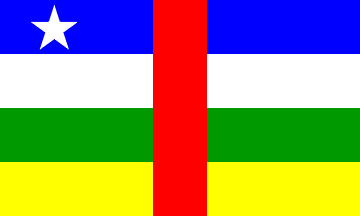 image
by António Martins-Tuválkin, 25 May 2008
image
by António Martins-Tuválkin, 25 May 2008
A stamp issues in 1961 commemorating the admission of the country to the United Nations shows a
white star on the flag, instead of yellow. This is not a printing mistake
as the yellow stripe of the flag is colored as expected. Three different
stamps in the same pattern were issued: 15, 25 and 85 francs (resp.
#02776, #02777 and #02778 in our catalogue of stamps on flags;
the 25F stamp was overprinted as "Fète Nationale 1-12-61" (our #02779).
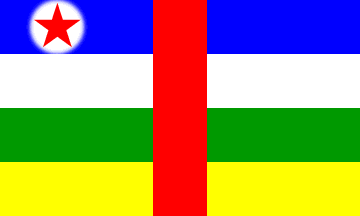 image
by António Martins-Tuválkin, 25 May 2008
image
by António Martins-Tuválkin, 25 May 2008
A 25F stamp issued in 1959 (our #02775) shows a national flag
and in the usual place
of the star, is a red star on a white disc - there doesn't appear to be a
crisp circle outline.
António Martins-Tuválkin, 25 May 2008


![[National flag]](../misc/oooxxx.gif)

 From http://www.chez.com/mdicentrafrique/sango.htm, located by Dov Gutterman, 10 Mar 1999
From http://www.chez.com/mdicentrafrique/sango.htm, located by Dov Gutterman, 10 Mar 1999



